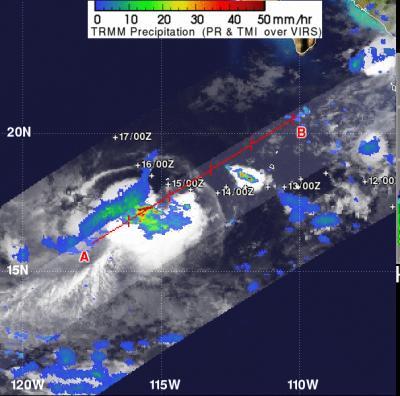Tropical Storm Hector is battling wind shear over the open waters of the Eastern Pacific Ocean, and NASA satellite data shows that has been affecting its organization and rainfall rates.
The Tropical Rainfall Measuring Mission satellite known as TRMM is managed by both NASA and the Japanese Space Agency. From its orbit in space, TRMM's instruments can estimate rainfall from tropical cyclones.
The TRMM satellite captured rainfall rates from Tropical Storm Hector on August 14, 2012 1:28 a.m. EDT. TRMM data showed that Hector had a small area of moderate to heavy rainfall around the center of circulation. That small area of heavy rainfall was falling at 2 inches/50 mm per hour. For the most part, rainfall was light-to-moderate in other areas of Hector.

The TRMM satellite captured rainfall rates from Tropical Storm Hector on Aug. 14, 2012 1:28 a.m. EDT. TRMM data showed that Hector had a small area of moderate to heavy rainfall around the center of circulation. Heavy rainfall appears in red, falling at 2 inches/50 mm per hour. Light to moderate rainfall is depicted in blue and green (falling at a rate between .78 to 1.57 inches (20 to 40 mm) per hour.
(Photo Credit: : SSAI/NASA, Hal Pierce)
Hector is being battered by moderate winds from the east, and that has been pushing the rainfall to the west of the storm's center. That wind shear is expected to be around for the next couple of days, which will prevent Hector from strengthening.
On Tuesday, August 14 at 11 a.m. EDT (1500 UTC) Hector's maximum sustained winds remained near 45 mph (75 kmh). The center of Tropical Storm Hector was about 230 miles (365 km) west-southwest of Socorro Island and about 440 miles (710 km) southwest of the southern tip of Baja California. That puts Hector's center near latitude 18.1 north and longitude 114.4 west. Hector is moving toward the west near 6 mph (9 kmh).
Hector is moving west and is expected to turn northwest before weakening into a remnant low pressure area by the end of the week.
Source: NASA/Goddard Space Flight Center